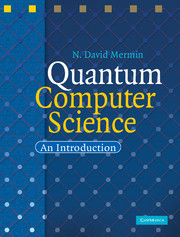Book contents
- Frontmatter
- Contents
- Preface
- A note on references
- 1 Cbits and Qbits
- 2 General features and some simple examples
- 3 Breaking RSA encryption
- 4 Searching with a quantum computer
- 5 Quantum error correction
- 6 Protocols that use just a few Qbits
- Appendices
- A Vector spaces: basic properties and Dirac notation
- B Structure of the general 1-Qbit unitary transformation
- C Structure of the general 1-Qbit state
- D Spooky action at a distance
- E Consistency of the generalized Born rule
- F Other aspects of Deutsch's problem
- G The probability of success in Simon's problem
- H One way to make a cNOT gate
- I A little elementary group theory
- J Some simple number theory
- K Period finding and continued fractions
- L Better estimates of success in period finding
- M Factoring and period finding
- N Shor's 9-Qbit error-correcting code
- O A circuit-diagrammatic treatment of the 7-Qbit code
- P On bit commitment
- Index
O - A circuit-diagrammatic treatment of the 7-Qbit code
from Appendices
Published online by Cambridge University Press: 05 June 2012
- Frontmatter
- Contents
- Preface
- A note on references
- 1 Cbits and Qbits
- 2 General features and some simple examples
- 3 Breaking RSA encryption
- 4 Searching with a quantum computer
- 5 Quantum error correction
- 6 Protocols that use just a few Qbits
- Appendices
- A Vector spaces: basic properties and Dirac notation
- B Structure of the general 1-Qbit unitary transformation
- C Structure of the general 1-Qbit state
- D Spooky action at a distance
- E Consistency of the generalized Born rule
- F Other aspects of Deutsch's problem
- G The probability of success in Simon's problem
- H One way to make a cNOT gate
- I A little elementary group theory
- J Some simple number theory
- K Period finding and continued fractions
- L Better estimates of success in period finding
- M Factoring and period finding
- N Shor's 9-Qbit error-correcting code
- O A circuit-diagrammatic treatment of the 7-Qbit code
- P On bit commitment
- Index
Summary
As a further exercise in the use of circuit diagrams, we rederive the properties of the 7-Qbit error-correcting code, using the method developed in Chapter 5 to establish that the circuit in Figure 5.11 gives the 5-Qbit codewords.
We start with the observation that the seven mutually commuting operators Mi, Ni (i = 0, 1, 2) in (5.42), and in (5.49), each with eigenvalues ±1, have a set of 27 nondegenerate eigenvectors that form an orthonormal basis for the entire seven-dimensional codeword space. In particular the two codeword states and are the unique eigen states of all the Mi and Ni with eigenvalues 1, and of with eigenvalues 1 and –1, respectively.
It follows from this that if a circuit produces a state |Ψ〉 that is invariant under all the Mi and Ni then |Ψ〉 must be a superposition of the codeword states and, and if |Ψ〉 is additionally an eigenstate of then, to within factors eiϕ of modulus 1, |Ψ〉 must be or depending on whether the eigenvalue is 1 or –1.
Figure O.1 shows that the state |Ψ〉 produced by the circuit in Figure 5.10 is indeed invariant under M0 = X0X4X5X6. This figure demonstrates that when M0 is brought to the left through all the gates in the circuit it acts directly as Z0 on the input state on the left, which is invariant under Z0.
- Type
- Chapter
- Information
- Quantum Computer ScienceAn Introduction, pp. 210 - 215Publisher: Cambridge University PressPrint publication year: 2007



